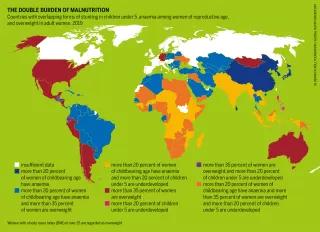
Malnutrition is increasing worldwide. Too little food inhibits early childhood development, while too many empty calories from sugar and fat may cause cardiovascular diseases or diabetes.

More than one-third of all humanity suffers from some form of malnutrition. That includes both people who are undernourished and who do not consume enough vitamins and minerals, and those who are overweight and obese. Obesity is not a problem of aesthetics, and it does not necessarily make someone ill. But it does increase the risk of particular diseases. Between 2005 and 2014, the number of hungry and undernourished people declined as a proportion of the world’s population.
But since 2017 it has increased significantly, and in 2020, some 768 million people were undernourished. At the same time, the number of overweight people is also increasing. In 2018, 1.9 billion adults were classified as overweight or obese. In the Global South, the number of overweight and obese children is growing faster than in the Global North. These countries face the double burden of malnutrition – undernourishment among some, accompanied by overweight and obesity among others.
Hunger particularly affects the development of children. Some 45.4 million children under the age of 5 (6.7 percent of all children) are “wasted” as a result of chronic undernourishment: they are too light for their height. Another 149.2 million, or 22 percent, of boys and girls are “stunted”: they are too short for their age. Some 45 percent of deaths among children under the age of 5 are attributed to undernourishment. Hunger is not confined to the Global South; it also occurs in the Global North. In 2019, 35.2 million Americans lived in households that sometimes did not have enough money to buy adequate food for themselves.
Obesity can make you ill. In the last 20 years, the incidence of non-communicable diseases that may be triggered by poor nutrition, among other things, has increased dramatically. In 2000, some 900,000 people worldwide died of diabetes; in 2019 it was 1.4 million. In 2019, heart disease and strokes were the most common illnesses worldwide. In 2020, they caused 15 million deaths; in 2000 the figure was just 12 million. The causes of overweight and obesity are complex. They result especially from changes in lifestyles and eating habits, combined with too little exercise.
The food crisis of 2008 illustrates how the increased consumption of highly processed foods can have structural causes. Women had to devote more time to earning money to feed their families, at the same time as bearing the bulk of responsibility for care work. In many countries it is mainly women who are responsible for preparing meals. Because they were left with too little time, they tended to buy highly processed food that is easy and quick to cook. Sales of such foods rose, along with the number of people who consumed fast food or ate in snack bars. As a result, the consumption of processed foods with high sugar and salt content rose.
The consumption of ultra-processed foods has come into focus as a cause of obesity. Such foods include sweetened drinks, snacks and frozen meals. They have a high calorie density and often contain cheap ingredients such as palm oil, sugar and starch. They have become part of the food system all over the world. Compared to other foods, ultra-processed items have a longer shelf-life, are more often ready to eat, and are more heavily marketed.
Despite their negative nutritional balance, between 25 and 60 percent of calorie needs (depending on the region) are satisfied from such foods. Market data show that sales of ultra-processed foods have grown fastest in south and southeast Asia, north Africa and the Middle East. Sales of highly processed beverages have grown most strongly in south and southeast Asia and in Africa. A healthy diet is a varied and nutritious diet. But such a diet is five times more expensive than one that merely supplies a person’s energy requirements through starchy staples.
Around the world, 3 billion people cannot afford a healthy diet. On a global average, it costs 79 US cents to supply a person with an adequate number of calories. It costs 2.33 US dollars to provide the same person with a diet that takes into his or her nutritional needs apart from calories. A healthy and varied diet that combines various types of food and that prevents deficiency symptoms and long-term nutrition-related diseases costs at least 3.75 US dollars per person per day. According to a United Nations report, only half of the world’s population can afford a healthy diet that would prevent malnutrition.

